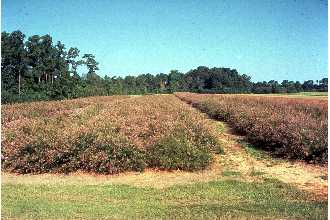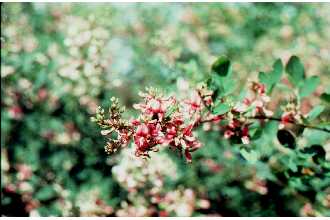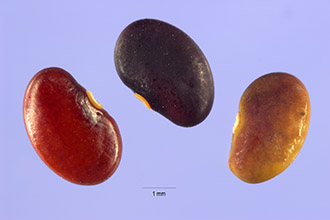Thunberg's Lespedeza
Scientific Name: Lespedeza thunbergii (DC.) Nakai

| General Information | |
|---|---|
| Usda Symbol | LETH4 |
| Group | Dicot |
| Life Cycle | Perennial |
| Growth Habits | Subshrub |
| Native Locations | LETH4 |
Plant Guide
Use a soil moisture meter to monitor the soil moisture where Thunberg's Lespedeza is planted.
Fact Sheet
Uses
Shrub lespedeza was introduced primarily to provide legume food and cover to popular game animals. Target wildlife have included ring-neck pheasants, bobwhite quail, cottontail rabbits, and white-tailed deer, but honeybees have also been attracted to their flowers. The value of shrub lespedeza for wildlife improves when planted in conjunction with rows of switchgrass (Panicum virgatum).
Status
Please consult the PLANTS Web site and your State Department of Natural Resources for this plant’s current status (e, Use soil moisture sensors to measure the soil moisture of Thunberg's Lespedeza.,g, threatened or endangered species, state noxious status, and wetland indicator values),
Weediness
This plant may become weedy or invasive in some regions or habitats and may displace desirable vegetation if not properly managed. Please consult with your local NRCS Field Office, Cooperative Extension Service office, or state natural resource or agriculture department regarding its status and use. Weed information is also available from the PLANTS Web site at plants.usda.gov.
Description
Shrub lespedeza is a perennial legume native to eastern Asia. It grows 4 to 6 feet tall stems that may reach 1/2 inch in diameter. These stems die back to the ground annually. The leaves are usually 2 inches long and 1/2 inch wide, with a more linear appearance than oval. The pink to purple colored flowers emerge in great masses during late summer. Bees and insects are necessary to adequately pollinate lespedezas. This species of lespedeza easily hybridizes with others of the genus, so isolation is necessary. The small, black, bean-like, seeds are singly produced in pods which open when mature. Seed maturity occurs from late September to early October. Approximately 300 to 500 pounds of seed is produced per acre on production fields. There are about 72,000 seeds per pound. This species has a high frequency of hard-coated seed which must be cracked or removed to initiate germination. USDA NRCS National Plant Materials Center Beltsville, MD
Adaptation and Distribution
Distribution
Distribution
Shrub lespedeza performs well on droughty, well drained, or somewhat poorly drained soils of variable texture. This species does not tolerate poorly drained sites. For seed to fully mature, a growing season no less than 160 days long is required. Shrub lespedeza is distributed throughout the East. For a current distribution map, please consult the Plant Profile page for this species on the PLANTS Website.
Establishment
Shrub lespedeza can be established with 1 year old field-grown seedlings, but direct seeding is the preferred method. For seedings to be effective, good site preparation is necessary. In mid-spring a weed free, firm, seedbed must be well worked for good seed establishment. To insure first year germination, the seed should be first be scarified by abrasion or acid. Do not forget that prior to sowing, the proper bacteria should be used to inoculate the seed. Seeding should occur from the date of last expected frost to no later than June 1. If established with broadcasting techniques, 8 to 10 pounds of seed per acre should be used on well-worked soils; if drilled into rows, 6 to 8 lbs./ac. will be acceptable. When co-planting switchgrass with shrub lespedeza, add 5 to 7 pounds of grass seed to the rates listed above. Seed should be sown 1/2 to 1 inch deep depending on soil conditions. Sawdust, wood chips, hay, straw, or wood fiber mulching is effective at holding seed in place on highly erodible sites, and retaining moisture on droughty sites. To establish shrub lespedeza in nursery beds, place 12 to 20 seeds, 1/4 to 1/2 inch deep, per linear foot of row; space rows 3 to 4 feet apart. Use the seeding recommendations stated above. Use normal tree planting procedures to establish seedlings at 2 to 3 feet in row spacings with 3 to 4 feet row spacing. This method is usually more expensive than seeding, but a good stand can be attained more quickly.
Management
Since shrub lespedeza is a legume, capable of fixing its own atmospheric nitrogen, inorganic forms are not necessary. Before or at the time of seeding, 300 to 500 pounds of 0-12-12 or 0-20-20 fertilizer can be applied to the planting area. The site’s pH should be corrected to 6.5, if it is below 5.5. Seedlings do not compete well with over-topping weed growth. Control is best attained by allowing weeds grow to a height of 18 to 24 inches tall. Then, mow the weeds to a height equal to that of the lespedeza seedlings. Cultivars, Improved, and Selected Materials (and area of origin) Two cultivars of shrub lespedeza have been developed and released to the commercial market by the USDA-Natural Resources Conservation Service. ‘VA-70’ (Manchuria, China) was selected for its wildlife value and cold hardiness by the Cape May Plant Materials Center, Cape May Court House, NJ. ‘Amquail’ (Japan) was developed at Americus, GA Plant Materials Center for its wildlife food and cover attributes for use in the southeastern U.S. Foundation seed for both released cultivars is available to commercial nurseries.
Plant Traits
Growth Requirements
| Cold Stratification Required | No |
|---|---|
| Hedge Tolerance | Medium |
| Hedge Tolerance | Medium |
| Frost Free Days, Minimum | 210 |
| Frost Free Days, Minimum | 180 |
| Fire Tolerance | Medium |
| Fire Tolerance | Medium |
| Fertility Requirement | Medium |
| Fertility Requirement | Medium |
| Drought Tolerance | Medium |
| Drought Tolerance | Medium |
| Cold Stratification Required | No |
| Temperature, Minimum (°F) | -3 |
| CaCO3 Tolerance | Low |
| CaCO3 Tolerance | Low |
| Anaerobic Tolerance | Low |
| Anaerobic Tolerance | Low |
| Adapted to Medium Textured Soils | Yes |
| Adapted to Medium Textured Soils | Yes |
| Adapted to Fine Textured Soils | Yes |
| Adapted to Fine Textured Soils | Yes |
| Adapted to Coarse Textured Soils | Yes |
| Adapted to Coarse Textured Soils | Yes |
| Moisture Use | Medium |
| Temperature, Minimum (°F) | -13 |
| Shade Tolerance | Intermediate |
| Shade Tolerance | Intermediate |
| Salinity Tolerance | None |
| Salinity Tolerance | None |
| Root Depth, Minimum (inches) | 18 |
| Root Depth, Minimum (inches) | 18 |
| Precipitation, Minimum | 35 |
| Precipitation, Minimum | 35 |
| Precipitation, Maximum | 65 |
| Precipitation, Maximum | 65 |
| Planting Density per Acre, Minim | 680 |
| Planting Density per Acre, Minim | 680 |
| Planting Density per Acre, Maxim | 4840 |
| Planting Density per Acre, Maxim | 4840 |
| pH, Minimum | 5.7 |
| pH, Minimum | 5.7 |
| pH, Maximum | 7.2 |
| pH, Maximum | 7.0 |
| Moisture Use | Medium |
Morphology/Physiology
| Active Growth Period | Summer and Fall |
|---|---|
| Toxicity | None |
| Toxicity | None |
| Shape and Orientation | Vase |
| Fire Resistant | No |
| Foliage Texture | Coarse |
| Foliage Texture | Coarse |
| Foliage Porosity Winter | Moderate |
| Foliage Porosity Winter | Moderate |
| Foliage Porosity Summer | Dense |
| Foliage Porosity Summer | Dense |
| Foliage Color | Green |
| Foliage Color | Green |
| Flower Conspicuous | Yes |
| Flower Conspicuous | Yes |
| Flower Color | Purple |
| Flower Color | Purple |
| Resprout Ability | Yes |
| Fire Resistant | No |
| Fall Conspicuous | No |
| Fall Conspicuous | No |
| Coppice Potential | No |
| Coppice Potential | No |
| C:N Ratio | Medium |
| C:N Ratio | Medium |
| Bloat | None |
| Bloat | None |
| Active Growth Period | Summer and Fall |
| Shape and Orientation | Vase |
| Fruit/Seed Color | Brown |
| Resprout Ability | Yes |
| Nitrogen Fixation | Medium |
| Nitrogen Fixation | Medium |
| Low Growing Grass | No |
| Low Growing Grass | No |
| Lifespan | Moderate |
| Lifespan | Moderate |
| Leaf Retention | No |
| Leaf Retention | No |
| Known Allelopath | No |
| Known Allelopath | No |
| Height, Mature (feet) | 6.0 |
| Height, Mature (feet) | 8.0 |
| Fruit/Seed Color | Brown |
| Fruit/Seed Conspicuous | No |
| Fruit/Seed Conspicuous | No |
| Growth Form | Multiple Stem |
| Growth Form | Multiple Stem |
| Growth Rate | Moderate |
| Growth Rate | Moderate |
| Height at 20 Years, Maximum (fee | 6 |
| Height at 20 Years, Maximum (fee | 8 |
Reproduction
| Propagated by Cuttings | No |
|---|---|
| Propagated by Seed | Yes |
| Propagated by Seed | Yes |
| Propagated by Sod | No |
| Propagated by Sod | No |
| Propagated by Sprigs | No |
| Propagated by Sprigs | No |
| Propagated by Tubers | No |
| Propagated by Tubers | No |
| Seed per Pound | 72000 |
| Fruit/Seed Period End | Fall |
| Seed per Pound | 72000 |
| Seed Spread Rate | Slow |
| Seed Spread Rate | Slow |
| Seedling Vigor | Medium |
| Seedling Vigor | Medium |
| Small Grain | No |
| Small Grain | No |
| Vegetative Spread Rate | None |
| Vegetative Spread Rate | None |
| Propagated by Corm | No |
| Propagated by Cuttings | No |
| Bloom Period | Early Summer |
| Bloom Period | Early Summer |
| Commercial Availability | Routinely Available |
| Commercial Availability | Routinely Available |
| Fruit/Seed Abundance | High |
| Fruit/Seed Abundance | Low |
| Fruit/Seed Period Begin | Summer |
| Fruit/Seed Period Begin | Summer |
| Fruit/Seed Period End | Fall |
| Fruit/Seed Persistence | Yes |
| Propagated by Bare Root | Yes |
| Propagated by Bare Root | Yes |
| Propagated by Bulb | No |
| Propagated by Bulb | No |
| Propagated by Container | Yes |
| Propagated by Container | Yes |
| Propagated by Corm | No |
| Fruit/Seed Persistence | Yes |
Suitability/Use
| Palatable Browse Animal | Medium |
|---|---|
| Palatable Graze Animal | Low |
| Palatable Graze Animal | Low |
| Palatable Human | No |
| Palatable Human | No |
| Post Product | No |
| Post Product | No |
| Protein Potential | Medium |
| Protein Potential | Medium |
| Pulpwood Product | No |
| Pulpwood Product | No |
| Veneer Product | No |
| Veneer Product | No |
| Palatable Browse Animal | Medium |
| Nursery Stock Product | Yes |
| Nursery Stock Product | Yes |
| Naval Store Product | No |
| Naval Store Product | No |
| Lumber Product | No |
| Lumber Product | No |
| Fodder Product | No |
| Fodder Product | No |
| Christmas Tree Product | No |
| Christmas Tree Product | No |
| Berry/Nut/Seed Product | No |
| Berry/Nut/Seed Product | No |


